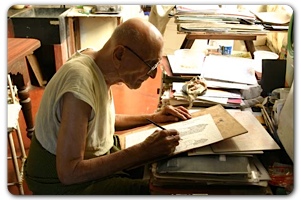
Sangita Kalasikhamani S. Rajam (1919-2010) was an internationally renowned vocalist, composer and painter who guided leading performers including Vijayalakshmy Subramaniam. He is credited with defining the visual identity of South India’s classical music during his lifelong research of traditional idioms combined with his own creative expression of music through sounds, colours and textures.
Even as a young man he knew his mind. He could separate wheat from chaff. He was riveted by carpentry from the art school days, as it taught him the importance of focussing, and precision at a manual level. “Never forget the concrete in the abstract,” he laughed, recalling the great astronomer who gazed at the stars and fell into a ditch.
Though the later years saw Rajam established as a musicologist and guru, member of many committees including the Experts’ Committee at the Music Academy, he had received ample recognition as a performer in his younger years. Connoisseur K. Chandrasekharan said, “I wonder which is more successful, your colour imagination or your sound imagination.” Rajam tapped the imagination of his sishyas, making them find their own way, while guiding them with arresting images and phrases to illuminate a raga or a composition. He could be epigrammatic: “Tala should be in the singer’s throat, not on his thigh.”
Rajam has done many series from Navagraha to Nayanmars — as commissioned paintings or magazine/book illustrations. Here too, he created his own bhani in “water colour wash.” His ubiquitous sangita mummoorti (earning Rs 200 in youth) has acquired the credibility of real life photographs.
Sundaram Rajam (1919-2010) lived an extraordinary life. He responded vibrantly to everything that life offered him – from masaaldosai to Mamallapuram sculptures. Till the very end, he remained a dedicated teacher ready to share his lakshya gnana of a bewildering variety, and his encyclopaedic lakshana gnana. He had a singular personality, though not as eccentric as his brother Veenai S. Balachander. His remarks on Balachander reveal his insight into the essence of art. “He started focussing on stretching the strings. That proved to be his undoing. You can’t depend on muscles alone in music, (in dance too) only abhinaya can serve you in the long run.”
Source: excerpt from Extraordinary life by Gowri Ramnarayan (The Hindu 5 Feb. 2010)
He served as producer for the India’s national radio corporation (All India Radio) and other major institutions. For many years, he contributed to Sruti Magazine (e.g. raga lakshana discussions and art work).
Countless books and periodicals were embellished by his artwork In addition to several drawings, the 2009 edition of the The Oxford Illustrated Companion to South Indian Classical Music includes eight full-page colour images that depict South Indian composers.
S. Rajam was the guiding light behind many educational and repertoire recordings: e.g. a set of three quality cassettes containing lovely songs by Koteeswara Iyer, a major composer of the 20th century (Geetha-Amudham: An Anjali by Sangeetha Kala Acharya S. Rajam and “Rasikas”; released in 2000 with a booklet of the Tamil lyrics).